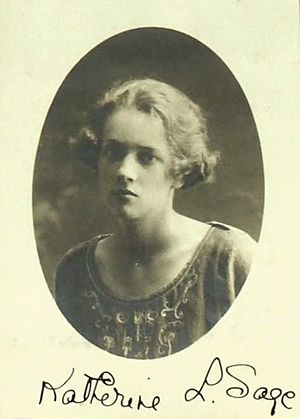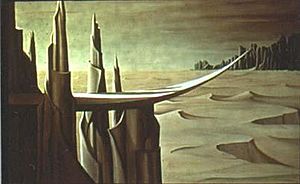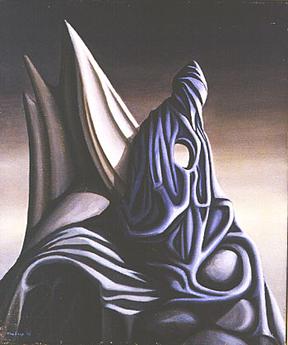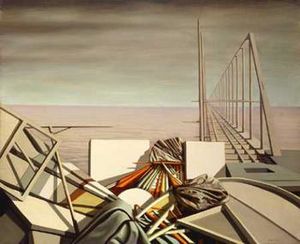Kay Sage facts for kids
Quick facts for kids
Kay Sage
|
|
|---|---|

Signed passport photo, 1922
|
|
| Born | June 25, 1898 |
| Died | January 8, 1963 (aged 64) |
| Nationality | American |
| Known for | Painting |
|
Notable work
|
Gallery |
| Movement | Surrealism |
| Spouse(s) | Ranieri Bourbon del Monte Santa Maria, Prince of San Faustino Yves Tanguy |
Katherine Linn Sage (born June 25, 1898 – died January 8, 1963), known as Kay Sage, was an American Surrealist artist and poet. She created art from 1936 to 1963. Kay Sage is famous for her paintings, which often show buildings and structures. She was an important artist during the "Golden Age" and "Post-War" periods of Surrealism.
Contents
Who Was Kay Sage?
Kay Sage was born in Albany, New York. Her family was wealthy because of the timber industry. Her father, Henry M. Sage, was a state senator. Her mother was Anne Wheeler (Ward) Sage. Kay also had an older sister named Anne.
Kay Sage's Early Life
Kay's mother left her father and older sister soon after Kay was born. She traveled in Europe with Kay. Her parents divorced in 1908. But Kay's father still supported them. Kay would visit him and his new wife in Albany. She often wrote letters to him.
Kay and her mother lived in Rapallo, Italy. They also visited many other places, including Paris. Kay learned to speak French and Italian very well. She learned these languages from the people who helped raise her. She went to several schools, like the Foxcroft School in Virginia. There, she became good friends with Flora Payne Whitney.
As a child, Kay enjoyed drawing and writing. Her first art lessons were at the Corcoran Art School in Washington, D.C., in 1919–1920. After returning to Italy in 1920, she studied art in Rome for several years. She learned traditional painting methods. She especially loved painting outdoors in the Roman countryside. She painted with her teacher Oronato Carlandi and other students. Later, Sage said these were the happiest days of her life. She felt that this experience helped her understand distance in her art. However, she often said she was self-taught. This might be because her later art was very different from what she learned in Rome.
Around 1923, Sage met a young Italian nobleman in Rome. His name was Ranieri Bourbon del Monte Santa Maria, Prince di San Faustino. They fell in love and married on March 30, 1925. For ten years, they lived a quiet life. Sage later called this time "a stagnant swamp." She felt she had "threw away" those years. She wanted to do something more meaningful.
Becoming a Surrealist Artist
Kay Sage decided to become an artist in 1935. This was after her father died in 1933 and her sister died in 1934. Her sister Anne had become very close to Kay during her illness. Kay left her husband and moved to Paris. Their marriage was later officially ended. In December 1936, she had her first art show in Milan, Italy. She showed six oil paintings. These were "experimental abstract compositions."
Sage moved to Paris in March 1937. In early 1938, she saw the International Surrealist Exhibit. This show had 299 artworks by 60 artists. She was very impressed by the paintings of Italian artist Giorgio de Chirico. His works often showed empty spaces and tall towers. Sage bought one of his paintings, La Surprise. She kept it her whole life.
Seeing this Surrealism art made Sage want to paint seriously. She showed six of her new paintings in Paris in 1938. These paintings were semi-abstract. They used ideas from de Chirico and the Surrealists. But they also showed hints of Sage's own unique style. Art experts say Sage's paintings had a feeling of stillness and coming danger. Around this time, she started signing her art "Kay Sage."
Kay Sage met her future husband, the Surrealist artist Yves Tanguy, around this time. Tanguy was married but separated. He and Sage quickly fell in love. Sage was still wealthy and helped the other artists, who were often poor. However, some artists did not like her wealth or what they saw as a proud attitude. Her relationship with Tanguy caused problems between Tanguy and André Breton, a leader of the Surrealist group. Even so, Sage continued to call herself a Surrealist.
When World War II started in September 1939, Sage returned to the United States. She immediately planned to help other Surrealist artists move to America. She wanted to help them show their art there. Tanguy joined her in New York City in November. She arranged a show for him at the gallery of Pierre Matisse. Sage had her own first solo show in the U.S. at the same gallery in June 1940. Sage and Tanguy married on August 17, 1940, in Reno, Nevada.
Kay Sage's Main Artworks
Sage created most of her famous paintings between 1940 and 1955. This was the time she was married to Tanguy. They lived at Town Farm in Woodbury, Connecticut. They turned a barn into separate art studios for each of them. Their home was filled with Surrealist art and unusual objects.
During these years, Sage's art became well-known. But it was sometimes hard for her to be seen as important as Tanguy. Her work was shown in national exhibits and won awards. Major art museums bought her paintings. In 1943, her art was part of Peggy Guggenheim's show Exhibition by 31 Women in New York. She had several solo shows at different galleries. Her painting In the Third Sleep won a major prize in 1945. In 1951, All Soundings Are Referred to High Water won first prize. Sage and Tanguy had a large joint art show in Connecticut in 1954. This was their only major show together.
Later Life and Passing
Kay Sage was deeply affected by Tanguy's sudden death in 1955. She wrote to a friend, "Yves was my only friend who understood everything."
After Tanguy died, Sage painted less. This was partly because she felt very sad and partly because her eyesight was getting worse. Instead, she focused on two things: keeping Tanguy's art famous and writing poetry. She wrote mostly in French. With help from a friend, her poetry book Demain, Monsieur Silber was published in France in 1957. Around 1955, she also wrote a book about her early life called China Eggs. She never published it.
One of her main paintings in a 1958 show was called The Answer Is No.
In 1959 and 1960, she had eye surgeries. They were painful and did not help much. She also had other health problems. In 1960 and 1961, she made small sculptures instead of painting. These were made from wire, stones, and other unusual items. A show of these sculptures, called "Your Move," happened in 1961. There was also a big show of her paintings in 1960.
In August 1961, Sage wrote in her journal, "I have said all that I have to say. There is nothing left for me to do but scream." On January 8, 1963, she died. Following her wishes, her ashes and Tanguy's ashes were buried in the ocean off the coast of Brittany in 1964.
Kay Sage's Art and Writing
Kay Sage's Poetry and Other Writings
Kay Sage is best known as a painter. But she also wrote five books of poetry, mostly in French. One of these was Faut dire c'qui est (1959). She also wrote four short plays and her unpublished book about her life, China Eggs.
What Was Kay Sage's Art Style Like?
Kay Sage always said she was a Surrealist. Experts who write about her usually agree. One writer, Judith Suther, said Sage's paintings have a strange and dreamlike quality. This was important to the Surrealist group. She also said that Sage's connection to Surrealism was key to how she saw herself as an artist.
During Sage's life, people often compared her art to Tanguy's. They thought his art influenced hers more. But newer experts say they likely influenced each other. They also point out differences. For example, Sage's paintings often have large buildings and structures. Tanguy's art usually has smaller, more organic shapes.
Kay Sage's mature artworks have some key features. Most of her paintings show tall, freestanding buildings, walls, and towers. These might look like buildings being built or old ruins. She often used arched doorways and slanted views. This might be from the painter Giorgio de Chirico. Some paintings have shapes that might be human figures, hidden by flowing cloth. Like Tanguy, Sage often placed her objects on flat, empty lands that stretch far away. She painted with great detail. Her colors were often gray-green and brown. These colors made her art look like the light before a thunderstorm. Critics often said her work felt unsettling or sad, even when they admired her skill.
Sage rarely explained what her paintings meant. One time, she told a Time magazine writer that her painting The Instant was "a sort of showing of what's inside—things half mechanical, half alive."
Famous Artworks by Kay Sage
- A Little Later (1938)
- An important event (1938)
- Noone Heard Thunder (1939)
- My Room Has Two Doors (1939)
- This Morning (1939)
- Tumble-weed (1939)
- Lost Record (1940)
- I Walk without Echo (1940)
- Danger, Construction Ahead (1940)
- I Have No Shadow (1940)
- White Silence (1941)
- Margin of Silence (1942)
- The Fourteen Daggers (1942)
- At The Appointed Time (1942)
- Minutes #8 (1943)
- The Hidden Letter (1943)
- Too Soon for Thunder (1943)
- From Another Approach (1944)
- I Saw Three Cities (1944)
- In the 3rd Sleep (1944)
- The Upper Side of the Sky (1944)
- Other Answers (1945)
- Journey to Go (1945)
- Festa (1947)
- On The First of March Crows Begin to Search (1947)
- Arithmetic of Wind (1947)
- All Soundings Are Referred to High Water (1947)
- Ring of Iron, Ring of Wool (1947)
- The Unicorns Came Down From the Sea (1947)
- The Seven Sleepers (1947)
- Starlings, Caravans (1948)
- The Instant (1949)
- The Morning Myth (1950)
- Small Portrait (1950)
- Men Working (1951)
- Tomorrow for Example (1951)
- Apostrophe (1951)
- Unusual Thursday (1951)
- On the Contrary (1952)
- Dreamy Cars of Waterbury (1952)
- Third Paragraph (1953)
- No Passing (1954)
- Hyphen (1954)
- A Bird in the Room (1955)
- Tomorrow is Never (1955)
- Journal of a Conjuror (1955)
- Le Passage (1956)
- South to Southwesterly Winds Tomorrow (1957)
- The World of Why" (1958)
- No Winds, no Birds" (1958)
- Watching the Clock (1958)
- The Answer Is No (1958)
- Passionnément, pas du tout (1961)
- Passe ou Manque (1961)
- Tacaii (1962)
Where Was Kay Sage's Art Shown?
- 1936, Galleria del Milione, Milan, Italy (six oil paintings)
- 1938, Salon des Surindependants, Paris, France (six oil paintings)
- 1940, Pierre Matisse Gallery, New York (17 oil paintings, solo show); Tone Price gallery, Los Angeles (13 oil paintings, solo show); San Francisco Museum of Art, San Francisco (13 oil paintings, part of group show)
- 1944, Julien Levy gallery, New York (18 oil paintings, solo show)
- 1947, Julien Levy gallery, New York (11 oil paintings, solo show)
- 1950, Catherine Viviano gallery, New York (14 oil paintings, solo show)
- 1952, Catherine Viviano gallery, New York (14 oil paintings, solo show)
- 1954, Wadsworth Atheneum, Hartford, Connecticut (46 artworks, joint show with Yves Tanguy)
- 1956, Catherine Viviano gallery, New York (12 oil paintings, solo show)
- 1960, Catherine Viviano gallery, New York (59 artworks, solo retrospective)
- 1961, Catherine Viviano gallery, New York (small Surrealist sculptures, titled "Your Move")
- 1965, Mattatuck Museum, Waterbury, Connecticut (memorial exhibit of 50 artworks, titled "A Tribute to Kay Sage")
- 1977, Herbert F. Johnson Museum of Art, Cornell University, Ithaca, New York (65 artworks, solo retrospective)
- 2011, The Katonah Museum of Art, Katonah, New York (25 artworks, joint show with Yves Tanguy)
- 2012, Featured in the exhibition In Wonderland: The Surrealist Adventures of Women Artists in Mexico and the United States at the Los Angeles County Museum of Art.
See also
 In Spanish: Kay Sage para niños
In Spanish: Kay Sage para niños
- Women Surrealists





